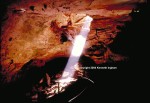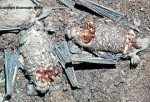| Cave Trophic Levels and Food Webs : What's for dinner? |
Caves are very different from the surface of the Earth for many reasons. Darkness is one of the biggest differences. Caves have little or no sunlight past the entrance/twilight zones. This darkness affects many things, including what's available to eat. |

Click on Picture for Larger Image
This picture demonstrates what a difference light makes in a cave. |
Click Here to Learn More About the Difference Between Cave and Surface Food Webs!
|
Click Here to Learn How Nutrient Cyclying Works in A Cave Food Web!
|
|
| Competition: |
|
Competition is not always important in organizing communities. It is more important when there isn't a lot of food or there are too many animals living in one place. For example in bat guano cave communities, competition is probably not very important because food is not limited (The guano is 1-30 feet deep in Carlsbad Cavern--all the poop you could want!).
|

Click on Picture for Larger Image
This picture shows two camel crickets competing for food.
|
|
|
| Predation: |
|
In the surface environment, most of the basic defenses against being eaten by a predator involve sight: camouflage (e.g. the pattern of colors on the animal's skin may hide it), flashing bright colors to warn that you're not tasty, having big spines to warn predators away. Just think about itónone of these would work in a cave where you can't see. So what do cave animals use as defenses? Discuss or write down some ideas.
|

Click on Picture for Larger Image
This picture shows how a much smaller animal (Rhadine Beetles) can be a predator to and feast on a 'giant' bat.
|
|
Food-Limitation and Patchiness of Cave Food Resources: |
Cave communities may be strongly affected by food: What the food is like, how much food there is, where the food is found, are all very important to a cave community. The species diversity of a cave declines and a few species take over the community when large amounts of food flow into a cave quickly. The species diversity of a cave is more balanced when food flows in slowly.
|

Click on Picture for Larger Image
This picture shows the great diversity of the entrance to a cave where there is the possibility for a more food. |
Click Here to Learn About Species Diversity!
|

















